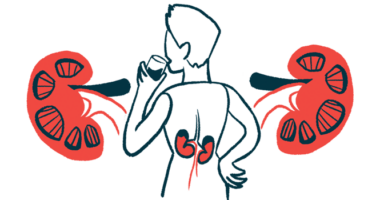Higher doses of Soliris needed for AHUS patient in rare case: Study
'Extremely rare' case of drug resistance seen in 43-year-old woman

Treatment with the drug Soliris (eculizumab) for atypical hemolytic uremic syndrome (aHUS) initially failed to ease the symptoms of a middle-age woman with AHUS and multiorgan involvement, a case study reported.
Higher Soliris doses eventually eased disease symptoms in all organs except the kidneys, which had to be replaced via a transplant.
“Cases of [Soliris] ‘resistance’ are extremely rare,” the researchers wrote, noting that this was the first reported case of confirmed bladder involvement in an aHUS patient.
“At two years post-transplant, [the patient’s] progress has been uncomplicated and without recurrence of aHUS or need for [Soliris] therapy,” the team wrote, adding, however, that “the question remains why her disease was resistant to [Soliris].”
The case study, “Atypical haemolytic uremic syndrome with refractory multiorgan involvement and heterozygous CFHR1/CFHR3 gene deletion,” was published in the journal BMC Nephrology.
Determining a treatment strategy for patients resistant to aHUS drug Soliris
Most people with aHUS have genetic variants that impair the body’s ability to control the activation of the complement cascade, a part of the immune system that helps defend the body against disease-causing microbes.
Typically triggered by an infection or disease, the uncontrolled activation of the complement cascade can lead to thrombotic microangiopathy (TMA) — the formation of blood clots in small blood vessels. TMA can cause damage to internal organs, especially the kidneys.
Soliris is an antibody-based therapy that suppresses complement activation and is the drug treatment of choice for most aHUS patients.
Still, “it is not clear what the best treatment strategy is for patients whose disease initially does not respond to [Soliris],” the researchers wrote.
That was the challenge for a team in Australia, led by researchers from Liverpool Hospital, in treating a 43-year-old woman with aHUS and multiorgan involvement who initially failed to respond to treatment with Soliris.
She arrived at the hospital with a one-day history of nausea, vomiting, and diarrhea with lower abdominal pain. For the prior two weeks, she also had been experiencing fatigue, swelling in the face and limbs, cognitive difficulties, and shortness of breath following exertion.
Her past medical history included multiple sclerosis, post-traumatic stress disorder, and generalized anxiety disorder. While the patient had two uncomplicated pregnancies, she also had endometriosis and had undergone a preventive mastectomy, or breast removal surgery, and ovary removal surgery known as oophorectomy.
Tests showed signs of kidney impairment, specifically including raised creatinine, decreased estimated glomerular filtration rate (eGFR), and a high urine protein-to-creatinine ratio. Low platelet counts and low levels of hemoglobin — the protein that carries oxygen in red blood cells — also were noted.
CT scans showed signs of inflammation in the lungs, so the woman was treated with various antibiotics for a potential infection. However, no infectious agents were identified.
Despite supportive measures, her kidney function continued to decline. She also developed fluid in the lungs and chest, and severe heart dysfunction with pulmonary hypertension, or high blood pressure in the blood vessels that connect the heart to the lungs.
No aHUS or need for Soliris drug therapy 2 years after kidney transplant
On day 13 of treatment, a kidney biopsy confirmed the presence of TMA.
From day 15-23, the woman had therapeutic plasma exchange, a form of treatment in which a person’s plasma — the liquid part of blood — is replaced. However, there were no improvements in hemoglobin levels, platelet counts, or kidney function.
Blood tests revealed elevated levels of several complement proteins. Her diagnosis of aHUS was confirmed after a genetic analysis revealed the presence of mutations in the CFHR1 and CFHR3 genes, both of which encode proteins that regulate complement activation.
In addition to blood and kidney involvement, the team suspected the woman’s disease had extended to the heart, lungs, digestive tract, and possibly the nervous system. Researchers suggested that “the initial infection triggered complement over-amplification in the presence of potentially contributory gene variants.”
She was started on weekly infusions of Soliris (900 mg), which led to some initial improvements. After three weeks of treatment, however, she developed bladder inflammation (hemorrhagic cystitis) in association with an upper respiratory tract infection.
“To our knowledge, this is the first reported case of biopsy-proven bladder involvement of aHUS,” the researchers wrote. “We postulate that in this patient, the second viral infection resulted in additional complement amplification.”
Soliris doses were increased to twice weekly, which greatly reduced the amount of blood in her urine. But ongoing cardiac failure and low platelet counts prompted an additional dose increase to 1,200 mg weekly.
Her platelet count normalized and stabilized with the higher dose, and symptoms associated with the digestive tract, lungs, heart, and nervous system finally eased. Nevertheless, her kidney function continued to deteriorate, with signs of TMA-related kidney damage, and she began dialysis.
This case highlights the concept of extra-renal manifestations in aHUS initially resistant to [Soliris], which potentially responded to dose intensification.
After three years of peritoneal dialysis, she underwent a kidney transplant. Two years later, there were no signs of aHUS and no need for Soliris drug therapy, with kidney function tests in the normal range.
“This case highlights the concept of extra-renal manifestations in aHUS initially resistant to [Soliris], which potentially responded to dose intensification,” the authors wrote. “Whilst organ injuries are potentially reversible with timely targeted treatment, it appears that the kidneys are most vulnerable to injury.”








